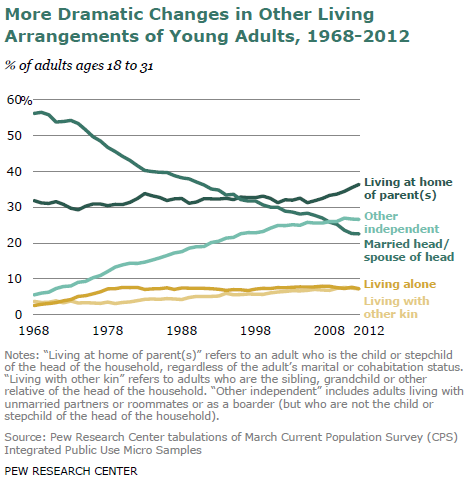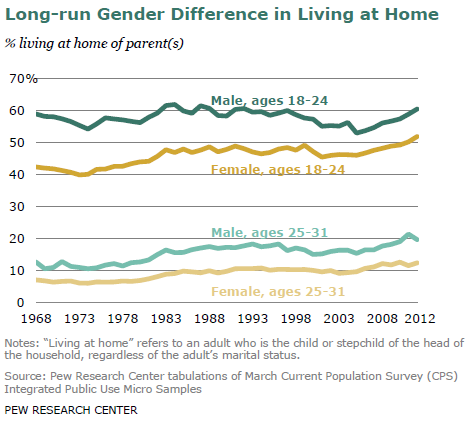(This is an excerpt from an article I originally published on Seeking Alpha on Aug 17, 2013. Click here to read the entire piece.)
The headlines seem pretty ominous: a record number of young adults aged 18-31 are living at home with their parents. The percentage of young adults under such living arrangements has shot up from 32 to 36% from 2007 to 2012. These are the media-grabbing headlines from a study released on August 1, 2013 from the Pew Research Center conducted by Richard Fry, Senior Research Associate, called “A Record 21.6 Million In 2012: A Rising Share of Young Adults Live in Their Parents’ Home.” Fry was interviewed on KQED’s The Forum along with other experts speaking on the topic of young adulthood:
On the surface, it seems that the recession has forced young people to retreat homeward. An increase in the percentage of young adults living at home also occurred during the last big recession in the early 1980s (Fry does not call this out and instead emphasizes how the aggregate percentages remained the same at specific snapshots: 1968, 1981, 2007). However, when the data are broken down by levels of education, age groups, and gender, the story becomes more nuanced. For example, it turns out that the most dramatic relative change since the recession has occurred with young adults aged 25-31. The percentage of these young adults living at home has not only risen but has also reached new highs. However, younger adults, those 18-24, have barely exceeded levels consistently last seen throughout the 1980s. Moreover, the data show that the slow rise for 25-31-year-olds is likely consistent with a slow shift that perhaps began in the early 1980s. So, I think the title of the graph below provided by Fry tells only half the story:

Moreover, the rate of household formation dropped just two percentage points from 2007 to 2012, from 35 to 33%. {snip}

The 3.1 million increase since 2007 in 18-31-year-olds who have chosen to live at home seems to dwarf the approximate 1.2 million “missing households” recently blamed on 18-34-year-olds abstaining from home ownership because of the recession’s fallout. {snip}
The most dramatic demographic change amongst young people is the change in marriage patterns…{snip}

{snip}
Finally, the breakdown by age and gender demonstrates that males aged 18-24 have experienced the most dramatic relative change of any group. {snip}

This change for men 18-24 is made all the more dramatic by the change in college enrollment. {snip}
I am suggesting that even more nuanced approach is required for these data. A closer look at the overall trends suggests that the recent changes are not quite as dramatic as they seem at first. I am even less convinced that the existing scale and scope of the demographic shifts will impede the progress of the nascent housing recovery. The standard fundamentals of employment and income will remain far more important. {snip}
Be careful out there!
(This is an excerpt from an article I originally published on Seeking Alpha on Aug 17, 2013. Click here to read the entire piece.)
Full disclosure: no positions
